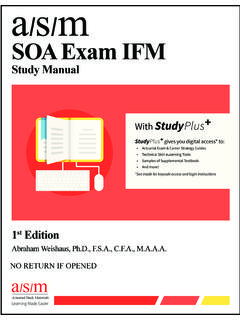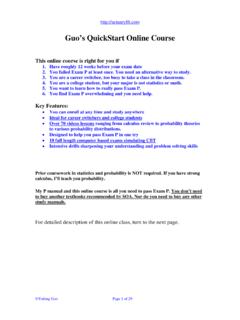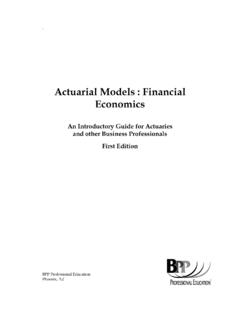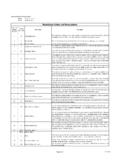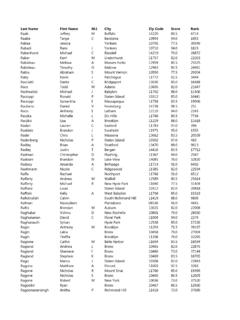Transcription of SOA Exam P - Actuarial Bookstore
1 Actuarial Study MaterialsLearning Made EasierStudyPlus+ gives you digital access* to: Flashcards & Formula Sheet Actuarial Exam & Career Strategy Guides Technical Skill eLearning Tools Samples of Supplemental Textbooks And more!*See inside for keycode access and login instructionsWith StudyPlus+S OA Exam PStudy Manual2nd EditionAbraham Weishaus, , , CFA, NO RETURN IF OPENEDC ontentsIntroductionviiCalculus Notesxi1 Sets1 Exercises ..5 Solutions ..132 Combinatorics19 Exercises ..24 Solutions ..283 Conditional Probability33 Exercises ..34 Solutions ..404 Bayes Theorem47 Exercises ..49 Solutions ..545 Random Insurance random variables ..63 Exercises ..64 Solutions.
2 686 Conditional Probability for Random Variables73 Exercises ..74 Solutions ..787 Mean83 Exercises ..88 Solutions ..948 Variance and other Bernoulli shortcut .. 105 Exercises .. 107 Solutions .. 1129 Percentiles117 Exercises .. 118 Solutions .. 121P Study Manual 2ndeditionCopyright 2017 ASMiiiivCONTENTS10 Mode125 Exercises .. 126 Solutions .. 12911 Joint Independent random variables .. Joint distribution of two random variables .. 135 Exercises .. 139 Solutions .. 14612 Uniform Distribution153 Exercises .. 156 Solutions .. 16013 Marginal Distribution169 Exercises .. 170 Solutions .. 17314 Joint Moments177 Exercises .. 178 Solutions.
3 18515 Covariance197 Exercises .. 200 Solutions .. 20616 Conditional Distribution213 Exercises .. 215 Solutions .. 22117 Conditional Moments231 Exercises .. 232 Solutions .. 23718 Double Expectation Formulas245 Exercises .. 247 Solutions .. 25119 Binomial Binomial Distribution .. Hypergeometric Distribution .. Trinomial Distribution .. 261 Exercises .. 262 Solutions .. 26920 Negative Binomial Distribution277P Study Manual 2ndeditionCopyright 2017 ASMCONTENTSvExercises .. 279 Solutions .. 28421 Poisson Distribution291 Exercises .. 292 Solutions .. 29622 Exponential Distribution303 Exercises .. 306 Solutions .. 31323 Normal Distribution323 Exercises.
4 326 Solutions .. 33124 Bivariate Normal Distribution339 Exercises .. 341 Solutions .. 34425 Central Limit Theorem349 Exercises .. 352 Solutions .. 35526 Order Statistics361 Exercises .. 364 Solutions .. 36827 Moment Generating Function373 Exercises .. 376 Solutions .. 38128 Probability Generating Function389 Exercises .. 393 Solutions .. 39429 Transformations397 Exercises .. 399 Solutions .. 40330 Transformations of Two or More Variables409 Exercises .. 411 Solutions .. 415P Study Manual 2ndeditionCopyright 2017 ASMviCONTENTSP ractice Exams4231 Practice Exam 14252 Practice Exam 24333 Practice Exam 34414 Practice Exam 44495 Practice Exam 54576 Practice Exam 6465 Appendices473A Solutions to the Practice Exams475 Solutions for Practice Exam 1.
5 475 Solutions for Practice Exam 2 .. 483 Solutions for Practice Exam 3 .. 491 Solutions for Practice Exam 4 .. 501 Solutions for Practice Exam 5 .. 511 Solutions for Practice Exam 6 .. 520B Exam Question Index533P Study Manual 2ndeditionCopyright 2017 ASML esson 1 SetsMost things in life are not certain. Probability is a mathematical model for uncertain assigns a number between 0 and 1 to each event. This number may have the followingmeanings:1. It may indicate that of all the events in the universe, the proportion of them included inthis event is that number. For example, if one says that 70% of the population owns a car,it means that the number of people owning a car is 70% of the number of people in It may indicate that in the long run, this event will occur that proportion of the time.
6 Forexample, if we say that a certain medicine cures an illness 80% of the time, it means thatwe expect that if we have a large number of people, let s say 1000, with that illness whotake the medicine, approximately 800 will be a mathematical viewpoint, probability is a function from the space of events to theinterval of real numbers between 0 and 1. We write this function asP[A], whereAis an often want to study combinations of events. For example, if we are studying people, eventsmay be male , female , married , and single . But we may also want to consider the event young and married , or male or single . To understand how to manipulate combinations ofevents, let s briefly study set theory.
7 An event can be treated as a set is a collection of objects. The objects in the set are called members of the set. Twospecial sets are1. The entire space. I ll use for the entire space, but there is no standard notation. Allmembers of all sets must come from .2. The empty set, usually denoted by . This set has no are three important operations on sets:UnionIfAandBare sets, we write the union asA B. It is defined as the set whose membersare all the members ofAplus all the members ofB. Thus ifxis inA B, then eitherxisinAorxis be a member of bothAandB. The union of two sets is always atleast as large as each of the two component sets, we write the intersection asA B. It is defined as the set whosemembers are in bothAandB.
8 The intersection of two sets is always no larger than each ofthe two component a set, its complement is the set of members of that are not members is no standard notation for complement; different textbooks useA ,Ac, and A. I lluseA , the notation used in SOA sample questions. Interestingly, SOA sample Study Manual 2ndeditionCopyright 2017 ASM121. SETS ABFigure :A B ABFigure :A BVenn diagramsare used to portray sets and their relationships. Venn diagrams display a setas a closed figure, usually a circle or an ellipse, and different sets are shown as intersecting ifthey have common elements. We present three Venn diagrams here, each showing a function oftwo sets as a shaded region.
9 Figure shows the union of two sets,AandB. Figure showsthe intersection ofAandB. Figure shows the complement ofA B. In these diagrams,AandBhave a non-trivial intersection. However, ifAandBare two sets with no intersection, wesay thatAandBaremutually exclusive. In symbols, mutually exclusive meansA B .Important set properties are:1. Associative property:(A B) C A (B C)and(A B) C A (B C)2. Distributive property:A (B C) (A B) (A C)andA (B C) (A B) (A C)3. Distributive property for complement:(A B) A B and(A B) A B Example1 ASimplify(A B) (A B ).P Study Manual 2ndeditionCopyright 2017 ASM1. SETS3 ABFigure :(A B) Answer:By the distributive property,(A B) (A B ) A (B B )ButBandB are mutually exclusive:B B.
10 So(A B) (A B ) A A Probability theory has three axioms:1. The probability of any set is greater than or equal to The probability of the entire space is The probability of a countable union of mutually exclusive sets is the sum of the probabil-ities of the these axioms, many properties follow, such [A] 1for [A ] 1 P[A]. [A B] P[A].Looking at Figure , we see thatA Bhas three mutually exclusive components:A B ,B A , and the intersection of the two setsA B. To computeP[A B], if we add togetherP[A]andP[B], we double count the intersection, so we must subtract its probability. ThusP[A B] P[A]+P[B] P[A B]( )This can also be expressed with and reversed:P[A B] P[A]+P[B] P[A B]( )P Study Manual 2ndeditionCopyright 2017 ASM41.



